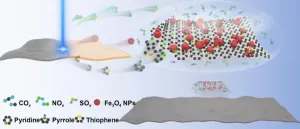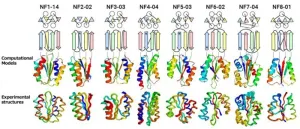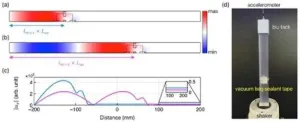(Press-News.org) An overdosed gene on chromosome 21 causes people with Down’s Syndrome to age faster than the general population.
The molecular processes responsible for natural ageing of cells are poorly understood. Studying conditions in humans where ageing is accelerated due to genetic causes presents opportunities to learn about the mechanisms that control ageing and devise strategies to slow down the ageing process.
Adults who have Down’s Syndrome (DS) show earlier signs of ageing-related conditions: reduction in tissue regenerative capacity, alopecia, dry skin, delayed wound healing, chronic gum disease, osteoporosis, senescence of the brain and immune cells. DS is a genetic, but not inheritable condition, caused by being born with an extra copy of chromosome 21 (trisomy 21). It affects around 7 million people worldwide (around 60,000 in the UK).
DS is the most frequent genetic cause of intellectual disability and early onset Alzheimer’s disease. While increased risk of early Alzheimer’s is clearly caused by an extra copy of the amyloid precursor protein gene (APP) encoded on chromosome 21, the genetic basis for the other conditions is not easily explainable.
New research published in the Lancet Discovery journal eBioMedicine, led by Queen Mary’s Professor Dean Nižetić and Dr Aoife Murray, with collaborating institutions from Croatia, Singapore, France, Italy and four other London universities, has uncovered an overdosed gene on chromosome 21 causes cells of people with DS to age prematurely.
The study has shown that biological age of people who have DS is on average 19.1 years older than the chronologically age-matched people who don’t have DS. The research has also shown that this is not caused by co-morbidities of DS, and that the premature ageing process starts very early in childhood. The gene for a kinase (a type of enzyme that speed chemical reactions in the body) called DYRK1A was identified as the main cause of the premature ageing component of DS, showing that this gene’s overdose disturbs the DNA-damage-repair mechanisms, causing cells to develop more breaks in their DNA and fragility of their cell nuclei.
Dean Nižetić, Professor of Cell and Molecular Biology at Queen Mary, said:
“We have uncovered that trisomic overdose of this gene (DYRK1A) is one of the main contributors to premature biological ageing in DS. Further research is needed to understand how much this contributes to brain development and function, and also in finding ways of precisely inhibiting the overdose of this gene back to physiological levels. This could open exciting new possibilities for early interventions in DS, but a lot more research is needed.”
Carol Boys, Chief Executive of the Down’s Syndrome Association, commented:
“We have known for a long time that people who have Down’s syndrome experience an ageing process which appears faster than in the general population.
To have a landmark research study like this, published by highly respected researchers, working together on an international basis is a pivotal development. Most importantly, the study hints at the prospect of effective treatments which may intervene in the accelerated cellular ageing process. This aspect of the research will be of huge interest to people who have Down’s syndrome and their families.”
The research has also shown that genetic or chemical reduction of the action of this gene has the potential to correct the cellular ageing defects. This opens possibilities for early therapeutic interventions for people with DS, to diminish the premature biological ageing effects on their development and well-being. These findings also shed more light onto the natural mechanisms of ageing and genes whose actions could be tackled to delay the natural ageing process and reduce the risk of common ageing-related diseases.
NOTES TO THE EDITOR
For more information, please contact:
Sophia Prout
Faculty Communications Manager – Medicine and Dentistry
Queen Mary University of London
Email: s.prout@qmul.ac.uk
Tel: +44 (0) 7718136512
Research paper
“Dose imbalance of DYRK1A kinase causes systemic progeroid status in Down syndrome by increasing the un-repaired DNA damage and reducing LaminB1 levels” Aoife Murray, Dean Nižetić, et al. eBioMedicine. 12 July 2023.
Available here after the embargo lifts: https://www.thelancet.com/journals/ebiom/article/PIIS2352396423002578/fulltext.
About Queen Mary
At Queen Mary University of London, we believe that a diversity of ideas helps us achieve the previously unthinkable.
Throughout our history, we’ve fostered social justice and improved lives through academic excellence. And we continue to live and breathe this spirit today, not because it’s simply ‘the right thing to do’ but for what it helps us achieve and the intellectual brilliance it delivers.
Our reformer heritage informs our conviction that great ideas can and should come from anywhere. It’s an approach that has brought results across the globe, from the communities of east London to the favelas of Rio de Janeiro.
We continue to embrace diversity of thought and opinion in everything we do, in the belief that when views collide, disciplines interact, and perspectives intersect, truly original thought takes form.
END
Queen Mary-led research uncovers why people who have Down’s Syndrome age prematurely
An overdosed gene on chromosome 21 causes people with Down’s Syndrome to age faster than the general population
2023-07-12
ELSE PRESS RELEASES FROM THIS DATE:
Scientists find evidence of world’s oldest glaciers
2023-07-12
Scientists have discovered the traces of the world’s oldest known glaciers, dating from 2.9 billion years ago, in rocks sitting under the world’s largest gold deposits in South Africa. This suggests the presence of continental ice caps at that time and that either the area was closer to the poles, or that parts of the Earth may have been frozen in a previously unknown “snowball Earth” period of extreme cold weather. This work is presented for the first time at the Goldschmidt geochemistry conference in Lyon, after recent peer-reviewed ...
Sea snakes may have evolved to see colors again
2023-07-12
A new paper in Genome Biology and Evolution, published by Oxford University Press, finds that the annulated sea snake, a species of venomous snake found in ocean waters around Australia and Asia, appears to have evolved to see an extended palette of colors after its ancestors lost that ability in response to changing environments.
Color vision in animals is primarily determined by genes called visual opsins. While there have been multiple losses of opsin genes during the evolution of tetrapods (the group including amphibians, reptiles, and mammals), the emergence of new opsin genes is extremely ...
Supercomputer used to simulate winds that cause clear air turbulence
2023-07-12
A research group from Nagoya University has accurately simulated air turbulence occurring on clear days around Tokyo using Japan’s fastest supercomputer. They then compared their findings with flight data to create a more accurate predictive model. The research was reported in the journal Geophysical Research Letters.
Although air turbulence is usually associated with bad weather, an airplane cabin can shake violently even on a sunny and cloudless day. Known as clear air turbulence (CAT), these turbulent ...
Sea snake vision evolved to regain color
2023-07-12
An international team of scientists examining the genetic history of sea snakes have found that the species has enhanced their colour vision in response to living in brighter and more colourful marine environments.
“Our research has found that the annulated sea snake possesses four intact copies of the opsin gene SWS1,” said PhD candidate Isaac Rossetto, from the University of Adelaide’s School of Biological Sciences who led the study.
“Two of these genes have the ancestral ultraviolet sensitivity, and two have evolved a new sensitivity to the longer wavelengths that dominate ocean habitats.
“The earliest ...
Scientists developed 180% relative bandwidth microwave absorber by ultrafast UV laser
2023-07-12
Scientists from Chinese Academy of Sciences Ningbo Institute of Materials Technology and Engineering, National Physical Laboratory (UK), The University of Manchester (UK) and National University of Singapore have developed a new approach, published in International Journal of Extreme Manufacturing (IF: 14.7), to fabricate a specifically designed wideband microwave absorption metamaterial with well-controlled electrical and magnetic characteristics on a polyethylene terephthalate (PET) substrate using ultraviolet (UV) laser irradiation.
The process involves using a UV laser to precisely control the characteristics of 2-D pattern on a specially formulated donor ...
Beyond nature's imagination: Scientists discover extensive array of protein folds unexplored in nature
2023-07-12
A groundbreaking study has shed new light on the astonishing diversity of protein structures and their folds in nature. Researchers set out to reveal the extent to which nature has explored the vast landscape of possible protein topologies. The results have unveiled an astounding array of unexplored protein folds, expanding our understanding and uncovering the depth of the protein universe.
This research has been published in the journal Nature Structural and Molecular Biology on July 3, 2023.
Proteins, ...
Bound states in the continuum is possible in the acoustoelastic coupling
2023-07-12
Let’s imagine a hypothetical scenario where two individuals are gripping a rope, each holding one end. Person A proceeds to shake the rope in an up-and-down motion, thus generating a propagating wave that travels towards person B. Now, if person C, positioned between person A and B, engages in a comparable frequency of waving motion as that of the rope’s wave, could the wave be redirected back to person A rather than reaching person B? Initially, this situation appears implausible, as person C does not physically ...
Pre-operative exercise substantially helps with recovery – study
2023-07-12
Policy-makers are being urged to take notice of a University of Otago study that confirms that undertaking a short programme of high intensity interval training before surgery can substantially help with recovery.
The study, published in the journal Surgery, reviewed and analysed 12 studies including 832 patients who had undertaken preoperative high-intensity interval training. Such training involves repeated aerobic high-intensity intervals at about 80 per cent of the maximum heart rate followed by active recovery.
Lead investigator Dr Kari Clifford says the study included all types of major surgeries – those expected ...
Scientists developing way to make cheaper Lithium batteries
2023-07-12
Lyon, France: Lithium is becoming the new gold, with rocketing use in lithium-ion batteries in electric cars, computers, and portable devices driving up the price and affecting the supply of the relatively rare metal. Scientists are on the verge of developing a way of using sodium to replace some of the lithium, so driving down costs and guaranteeing the supply.
Recently scientists have looked at dispensing with lithium altogether and instead using sodium or other elements in high quality batteries. Sodium is cheaper and more available (it’s found in seawater, as sodium chloride), but they have ...
Plant Biology 2023 plenary closeup: Connecting the dots
2023-07-12
This year’s Presidential Symposium places plant science within a larger context, spotlighting the connections between plants and humanity. Accordingly, ASPB President Gustavo MacIntosh selected speakers with a broad array of backgrounds and expertise. Yet when the Presidential Symposium takes place Saturday, August 5, at 1:30 pm, you’ll find they agree on critical fundamentals.
“Humans are totally dependent on plants for food,” began Barbara Schaal of Washington University.
“When it comes to agriculture, plants and people are really ...
LAST 30 PRESS RELEASES:
Longest observation of an active solar region
Why nail-biting, procrastination and other self-sabotaging behaviors are rooted in survival instincts
Regional variations in mechanical properties of porcine leptomeninges
Artificial empathy in therapy and healthcare: advancements in interpersonal interaction technologies
Why some brains switch gears more efficiently than others
UVA’s Jundong Li wins ICDM’S 2025 Tao Li Award for data mining, machine learning
UVA’s low-power, high-performance computer power player Mircea Stan earns National Academy of Inventors fellowship
Not playing by the rules: USU researcher explores filamentous algae dynamics in rivers
Do our body clocks influence our risk of dementia?
Anthropologists offer new evidence of bipedalism in long-debated fossil discovery
Safer receipt paper from wood
Dosage-sensitive genes suggest no whole-genome duplications in ancestral angiosperm
First ancient human herpesvirus genomes document their deep history with humans
Why Some Bacteria Survive Antibiotics and How to Stop Them - New study reveals that bacteria can survive antibiotic treatment through two fundamentally different “shutdown modes”
UCLA study links scar healing to dangerous placenta condition
CHANGE-seq-BE finds off-target changes in the genome from base editors
The Journal of Nuclear Medicine Ahead-of-Print Tip Sheet: January 2, 2026
Delayed or absent first dose of measles, mumps, and rubella vaccination
Trends in US preterm birth rates by household income and race and ethnicity
Study identifies potential biomarker linked to progression and brain inflammation in multiple sclerosis
Many mothers in Norway do not show up for postnatal check-ups
Researchers want to find out why quick clay is so unstable
Superradiant spins show teamwork at the quantum scale
Cleveland Clinic Research links tumor bacteria to immunotherapy resistance in head and neck cancer
First Editorial of 2026: Resisting AI slop
Joint ground- and space-based observations reveal Saturn-mass rogue planet
Inheritable genetic variant offers protection against blood cancer risk and progression
Pigs settled Pacific islands alongside early human voyagers
A Coral reef’s daily pulse reshapes microbes in surrounding waters
EAST Tokamak experiments exceed plasma density limit, offering new approach to fusion ignition
[Press-News.org] Queen Mary-led research uncovers why people who have Down’s Syndrome age prematurelyAn overdosed gene on chromosome 21 causes people with Down’s Syndrome to age faster than the general population






